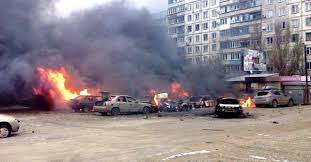Russian demands that Ukrainian forces in Mariupol lay down arms and hoist white flags on Monday in exchange for safe passage out of the beleaguered key port city were vehemently rebuffed by Ukrainian officials.
Even as Russia continued its bombardment of Mariupol in an attempt to force it to capitulate, its offensive in other parts of Ukraine has stalled. The broader fight, according to Western governments and observers, is deteriorating into a war of attrition, with Russia continuing to bombard cities.
A commercial complex near the city center in Kyiv was destroyed by Russian shelling, killing at least eight people and leaving a sea of wreckage amid scarred high-rises. Russia also bombarded a chemical facility in northeastern Ukraine, causing an ammonia leak, and a military training base in western Ukraine with cruise missiles, according to Ukrainian authorities.
Under Russian pounding for more than three weeks, the surrounded southern city of Mariupol on the Sea of Azov has seen some of the greatest tragedies of the war. According to Ukrainian sources, strikes targeted an art school that was sheltering 400 people just hours before Russia offered to open two routes out of the city in exchange for the surrender of its troops.
Even before Russia’s deadline of 5 a.m. Moscow time (0200GMT) for a response passed, Ukrainian officials rejected Russia’s offers for safe passage out of Mariupol.
“There can be no talk of surrender or armaments laying down,” Ukrainian Deputy Prime Minister Irina Vereshchuk told Ukrainian Pravda. “This has already been communicated to the Russian side.”
According to the news agency Interfax Ukraine, Mariupol Mayor Piotr Andryushchenko likewise swiftly rebuffed the offer, claiming in a Facebook post that he didn’t need to wait until the morning deadline to react and criticizing the Russians.
Col. Gen. Mikhail Mizintsev of Russia had proposed two routes, one leading east to Russia and the other west to other parts of Ukraine. He made no mention of what Russia would do if the offer was turned down.
According to the Russian state news agency RIA Novosti, the Russian Ministry of Defense threatened authorities in Mariupol may face a military tribunal if they sided with “bandits.”
Attempts to evacuate the people of Mariupol and other Ukrainian cities have failed or only partially succeeded, with shelling continuing as the population attempted to flee. At least 2,300 people have died in the siege, according to Mariupol officials, with some buried in mass graves.
A Russian bombardment attacked the school where around 400 civilians were taking shelter ahead of the rejected surrender offer, and it was unclear how many people were killed, Ukraine’s President Volodymyr Zelensky stated in a televised speech early Monday.
“They’re buried under rubble, and we have no idea how many have survived,” he said. Ukraine will “shoot down the pilot who dropped that bomb,” he claimed.
The strike at the art school was the second attack on a public building where Mariupol people had sought refuge in less than a week, according to officials. On Wednesday, a bomb detonated in a theater where over 1,000 people were thought to be hiding. On Friday, at least 130 individuals were allegedly rescued, but there has been no further information since then.
Food, water, and power have all run out in Mariupol, according to city officials and aid organizations, and humanitarian convoys have been kept out by fighting. The lines of communication have been cut.
Some of those who were able to evacuate Mariupol wept as they arrived by rail in Lviv, nearly 1,100 kilometers (680 miles) to the west, on Sunday.
“Battles raged down every street.”Every house became a target,” Olga Nikitina said as she exited the train, embraced by her brother. “The windows were blown out by gunfire. The temperature in the apartment was below zero.”
Russian soldiers in southern and eastern Ukraine would be able to combine if Mariupol fell. However, Western military analysts believe that even if the city is taken, the troops struggling for control of the city one block at a time may be too tired to assist Russia in securing advances on other fronts.
Experts say that more than three weeks into the invasion, the two sides appear to be trying to wear each other down, with bogged-down Russian forces launching long-range missiles at cities and military bases and Ukrainian forces launching hit-and-run attacks and attempting to cut off Russian supply lines.
Russian President Vladimir Putin’s forces on the ground are effectively halted, according to US Defense Secretary Lloyd Austin.
Austin told CBS on Sunday, “It’s had the effect of him transferring his energies into a woodchipper.”
Talks between Russia and Ukraine have resumed, but they have not succeeded in bridging the gap between the two countries, with Russia insisting that Ukraine disarm and Ukraine asking that Russian forces leave the entire nation.
President Joe Biden of the United States was scheduled to meet with the leaders of France, Germany, Italy, and the United Kingdom later Monday to discuss the conflict, before traveling to Brussels and then Poland later this week for in-person meetings.
Hundreds of men, women, and children have been killed in Russian attacks in Ukraine’s largest cities.
A Russian shell struck a chemical facility outside the eastern city of Sumy soon after 3 a.m. Monday, creating a leak in a 50-ton ammonia tank that took hours to contain, according to Ukraine’s prosecutor general.
Igor Konashenkov, a Russian military spokesman, stated the leak was a “premeditated provocation” by Ukrainian forces in order to falsely accuse Russia of a chemical strike.
A military training camp in the Rivne region of western Ukraine was also targeted overnight, according to Konashenkov. He claimed that 80 foreign and Ukrainian forces had been killed, albeit this number could not be independently verified. The chief of the Rivne regional military administration, Vitaliy Koval, acknowledged a double Russian missile strike on a training site there early Monday but did not provide any specifics on injuries or deaths.
According to emergency services in Kyiv, eight people were killed by shelling in the densely populated Podil area, not far from the city center, on Sunday. It destroyed a commercial complex, leaving flattened rubble in the midst of high-rise towers that were still smoking Monday morning. Every window in the high-rise next door was smashed by the power of the explosion and twisted their metal frames.
The sound of artillery could be heard in the distance as firefighters worked their way through the wreckage. According to Vitali Klitschko, the mayor of Kyiv, Russian shelling hit many homes in Podil. Klitschko declared a curfew in the capital from Monday evening to 7 a.m. local time on Wednesday, advising inhabitants to stay at home or seek refuge in shelters. There will be no stores, pharmacies, or petrol stations open.
For the fourth week in a row, Russian troops have been bombing Kyiv in an attempt to encircle the capital, which had a population of about 3 million people before the war.
The majority of Russian forces have been maintained more than 25 kilometers (15 miles) from the city center, according to the British defense ministry, although Kyiv “remains Russia’s primary military target.”
The United Nations has recorded 902 civilian deaths in the conflict but admits that the true toll is likely significantly higher. According to the report, approximately 3.4 million people have fled Ukraine. The number of Russians killed varies, but even conservative estimates are in the tens of thousands.
At least 115 children have been killed and 148 have been injured, according to the Ukrainian prosecutor general’s office.
In the midst of a massive crackdown on dissent, some Russians have also departed the country. Thousands of anti-war protestors have been detained in Russia, which has also censored independent media and restricted access to social media sites such as Facebook and Twitter.

















